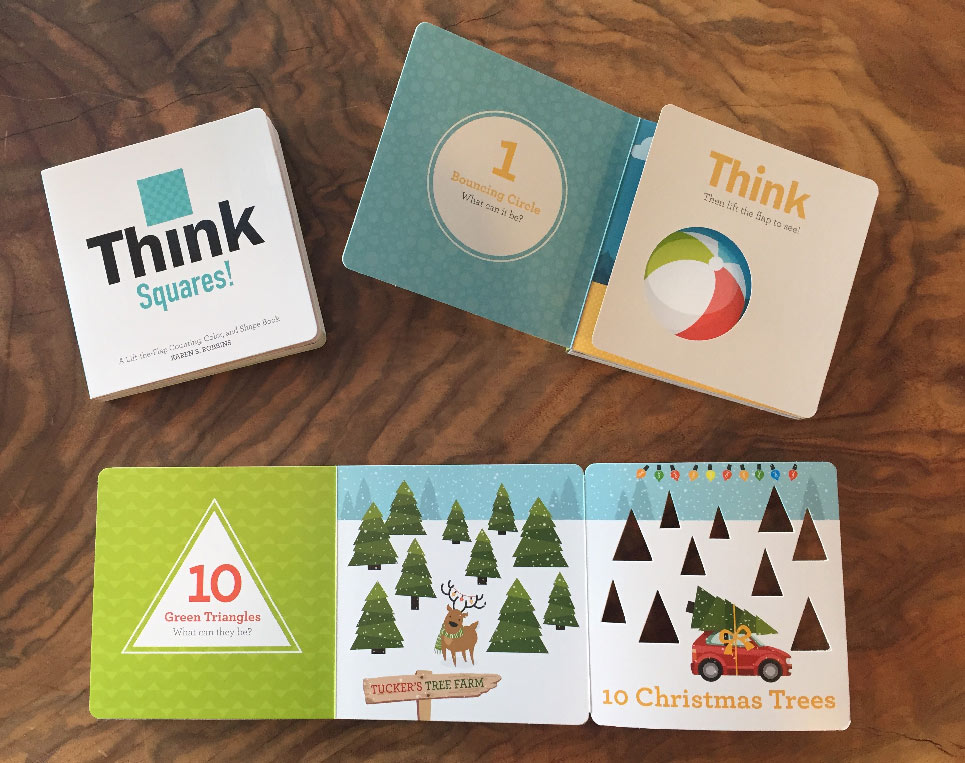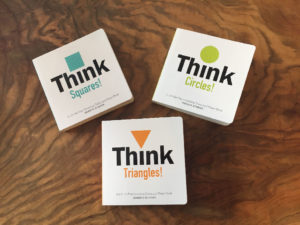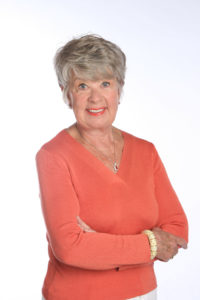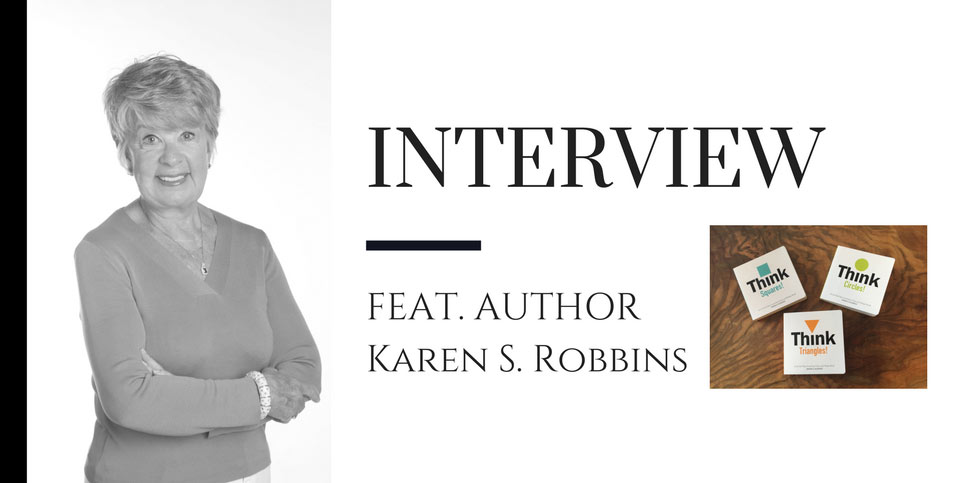Author Showcase
Interview sponsored* by Schiffer Publishing
The Children’s Book Review | December 18, 2017
The Children’s Book Review: As a former Romper Room teacher and educator who specializes in young children, can you explain why you believe early childhood reading and learning is important?
Karen S. Robbins: The first five years of a child’s life are the most formative and critical. I know mothers who have read children’s books to the fetus in the womb. Children need to learn language to have a voice in the world and to become educated. Learning to read is essential to all other forms of learning in school. Young children need to learn basic concepts from books and need to be introduced to books appropriate to their age level, to encourage the love of books and learning for success in life.
Think Shapes! is your new board book series that manages to increase both language and math skills, while also helping to develop small motor skills and hand-eye coordination. How clever to have created a series that manages to cross-educate with multiple basic concepts in each individual book. How did you come up with this concept, including the lift-the-flaps and peek-a-boo style die cuts?
How did I come up with this lift-the-flap, die-cut concept? I was at a networking event in Seattle, WA and a man handed me his business card as he left. I looked at it, and stared at the six and seven die cut circle holes for Six and Seven Restaurant in Seattle. I had never seen a business card, with die cut circles. I kept thinking about it as I drove home, and immediately could see it becoming a peek-a-boo book for kids. One red circle, what can it be? Peek-a-boo, peek-a-boo peek and see. Underneath the circle would be a clown’s nose. Under two circles could be eyes, and three circles would be the traffic light. The next morning, I wrote down 1-10 different images, and then started cutting out the die cut shapes from card stock and creating collage art images underneath. I made up several dummies and had them comb bound and started mailing them to various publishers. I still have the business card, and must stop by to thank Six and Seven Restaurant for the idea. Their business card gave me the idea to create educational novelty books for children world-wide. I would never have come up with this concept, without attending that event and receiving his business card. This took place in 2004. Thirteen years ago!
The books include Think Squares!, Think Circles!, and Think Triangles! Which of these shapes do you think kids tend to gravitate toward the most?
Which book do children gravitate to most depends on the day. Children of all ages simply pick up the book closest to them. They open them up and play with the holes by poking and pulling their fingers in and out. They turn the pages looking at the pictures and talking in their own sweet language. One book isn’t more appealing than another. The adorable art captures their attention and they have fun looking at the pictures on each page. From what I’ve heard and seen so far, children like THINK CIRCLES!, THINK SQUARES!, and THINK TRIANGLES! equally. They’re all cute, fun, interesting, and interactive for little hands and eyes to enjoy playing with recognizable objects such as kites, wrapped gifts, and robots. Also, triangle is a three syllable word that is fun for little kids to say around four to five. Just saying triangle makes them feel BIG! Summer sails in a sail boat, candy corn for Halloween, and green trees on Tucker’s Christmas Tree Farm will help celebrate children’s favorite holidays. Triangles are so much fun!

The repetitive text will easily capture the reader’s attention, helping them to catch on to the playful learning experience quickly. Is this the intention behind using repetition?
Absolutely! The simple repetitive text in rhyme will help children begin to read. Reading rhyme is easier for beginning readers and this is what I intended. Toddlers will even be repeating the verse, “What can it be? Think! Then lift the flap to see!” The rhyme and repetition becomes magical for the very young. Reading is difficult for most children, and that’s why Schiffer’s Think Shapes! series is such a great series for beginning readers including those with special needs. I want children to feel smart, and gain confidence. Reading is similar to learning to ride a bicycle. It’s tough at first, but once you catch the motion, you’re coasting downhill.
Illustrated in warm, bright colors, kids will discover things like one warm square waffle, seven juicy and circular oranges, and nine cold triangular ice cream cones. How did you devise the list of kid-friendly images that kids would get to discover in each book?
Devising the list of kid-friendly images that kids would get to discover was like playing a game for kids. I’ve always heard that if you want to write for children, you must think like a child. My entire life has been devoted to the young child in some way. I’ve particularly loved preschool and kindergarten children and have focused most of my writing to this age group. Or, maybe I’ve simply never grown up! I started the circle book first, and made a list from 1-10. Then I brainstormed circle items that would be familiar to young children. Some matched perfectly such as 1 ball, 2 eyes, 3 traffic lights which is an important lesson to teach to all young children. (They must learn what red, yellow, and green mean.) For the circle book, I was hand cutting all of the circles to make a dummy to submit to publishers and I chose items that would be fun, educational, and easy enough to make 7, 8, 9, and 10.
Were there any initial images that had to get cut from the books because they were too difficult to guess once presented through the die-cut holes?
This is how I created the items for Think Squares! and Think Triangles! too. I wanted the first three images to be easy so the child has fun and feels success. I want them to say, “I love this Think book. It’s fun to play! I’m smart!” I also chose items that would be introducing new images and language. So, I tried to create a balance of familiar, new, easy, and challenging. Here again, there’s a huge difference between young children, environment, experiences, and culture. I tried to find images that would be a nice balance for children world-wide. Fortunately, I don’t think any of the images had to be cut. I think this was due to the careful skill by Schiffer’s graphic designer, Brenda McCallum.
How closely did you work with illustrator/designer Brenda McCallum?
As I mentioned earlier, I first created the die cut lift the flap concept as a Peek-a-boo book thirteen years prior. It came close to being acquired by several other publishers, but fortunately I made contact with Schiffer Books and they were interested in creating this innovative concept into a series. I had created the collage art for all the three shape books, and wasn’t involved with Brenda making the first stage of development for Think Circles! I was involved more with Think Squares! and Think Triangles!. Brenda, my editor, Cheryl Weber, and I have worked cooperatively creating the other books in the series. Combining our three different backgrounds and skills (Cheryl as editor, Brenda as graphic designer, and myself as an educator of young children) made for a powerful package with six eyes looking at every aspect. I’ve enjoyed being involved and feel working together we’ve created fun, entertaining, educational, innovative books for children to think and learn through play.
What goes into the designing of such a book to make sure that all of lift-the-flaps and the die cuts line up accordingly with the underlying image?
Karen S. Robbins: This is a difficult question to answer because I didn’t have a part in making the lift the flaps and die cuts with the underlying images. This is a question which Brenda could answer. I know she worked with InDesign. It must have been quite a difficult challenge. I think the quality of paper, printing, color, durability is superior in every way. I couldn’t be happier! I believe children deserve the BEST and I am so proud of this new series published by Schiffer Books.
Brenda McCallum: When each spread was designed I used white circles, squares or triangles (Holes) to mark the spot where the die cut would be. For the back side of the page I copied and reversed the Holes to match the front making sure no type would be cut off. Before it went to print all the white holes were removed from the artwork and a die cut layer was created for the printer.
Can you tell us something that even your most loyal fans may not know about you?
Well, most of you know that when I was 24 years old, I traveled to Rochester, New York, to be the Romper Room teacher, “Miss Karen”, on WOKR TV. At this time, RR was the only educational TV show for children and I loved teaching children to be “Do Bees!” The show was live with six children, four to five years old, playing school with the children at home. It was one of my most fun, exciting, challenging jobs of my career.
But do you know I’m an inventor with a U.S. patent? That’s right. I obtained a U.S. patent on a folding apparatus which I’ve developed into a line of novelty books, greeting cards and educational flash cards. Leo Paper partnered with me for two years and had dummies made in their plant in China. Many publishers have been interested, and it’s been an amazing journey beyond my imagination! I’m still seeking to find a home for my line of Push and Peek books and cards.
Do you know that my award-winning picture book, Care For Our World, published by Compendium has been made into an app by Sunbreak Games? My 285 words in rhyme have gone worldwide! It’s beyond my wildest dreams! Be sure to check it out in the app store.
I have also created a line of craft kits for kids that I’m hoping to find a home; along with a beginner’s board game that is fun, quick, and educational for children three to ten.
Is there anything else that you would like to share with our readers?
I feel so fortunate to be able to use my educational background, creativity and imagination, to create books and toys for children. It’s my passion and purpose and my greatest gift to give our world. I’m so lucky I found Schiffer Books and look forward to creating many more books together. It’s more than a dream come true!
—
 Think Shapes! Series
Think Shapes! Series
Written by Karen S. Robbins
Illustrated by Brenda McCallum
Praise: “If you’re looking for a stimulating and enjoyable reading experience that will stretch the brain muscles and prime your precocious toddler, this is the next book series for you.”
Think Circles! Available Here:
Think Triangles! Available Here:
Think Squares! Available Here:
About The Author

Karen S. Robbins
Former Romper Room teacher Karen Robbins is an award-winning children’s author, book/toy designer, and educator who specializes in the young child. She has a master’s degree in education and lives in Gig Harbor, Washington.
The Author Showcase is a place for authors and illustrators to gain visibility for their works. This interview was sponsored* by Schiffer Publishing, the publisher of ‘Think Shapes!,’ by Karen S. Robbins. Discover more great writing and illustrating artists in our Showcase.


2 Comments
Thanks Bianca for featuring me in The Children’s Book Review, and for all you’re doing to share your passion for children’s literature to grow readers. I’m grateful to Schiffer Books who published my THINK CIRCLES, THINK TRIANGLES, and THINK SQUARES for toddlers, preschoolers and kindergartners. They’re fun books to help little ones think while playing the lift the flap game. Children are the future! We need to help them get an early start to be smart and kind. Thanks for your help! Karen Robbins
You are very welcome, Karen! Thank you for writing these great books and for your kind words!